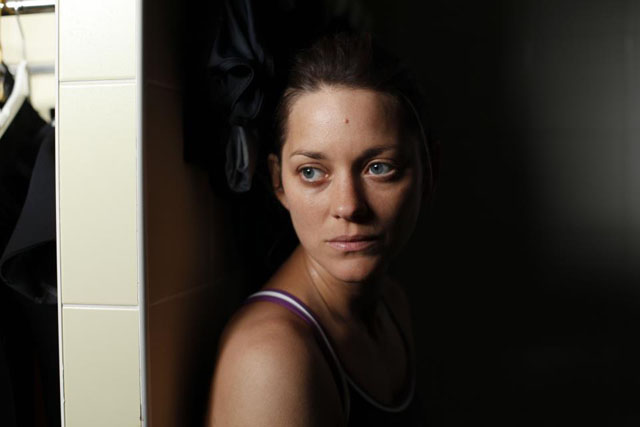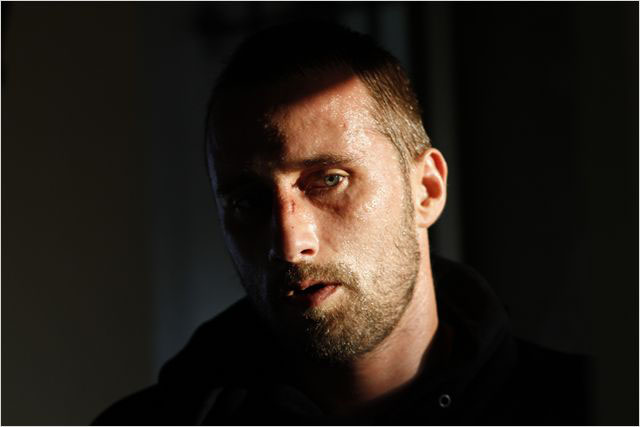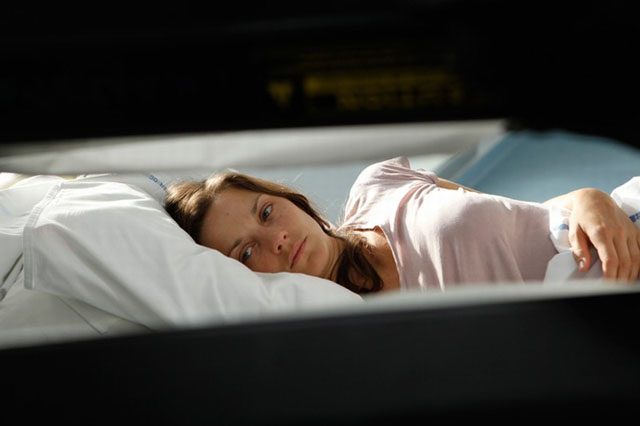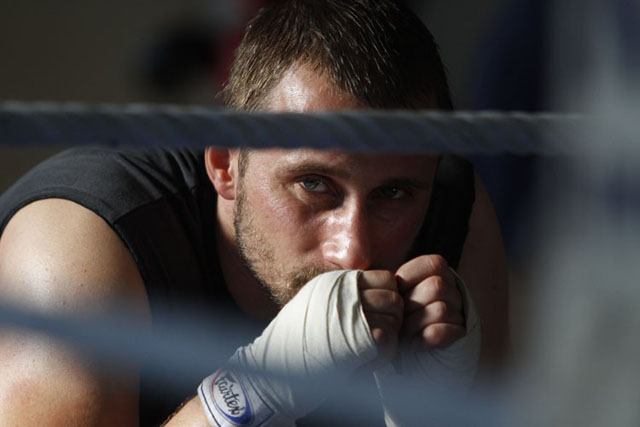“What could have been simply bizarre, sentimental or contrived here becomes an utterly absorbing love story,” begins the Guardian‘s Peter Bradshaw. “Rust and Bone is a tale of a miraculous friendship which evolves into an enthralling and moving romance, wonderfully acted by Marion Cotillard and Matthias Schoenaerts. Jacques Audiard directs, and his screenplay, co-written with Thomas Bidegain, is freely adapted from characters in the short story collection of the same title, by the American author Craig Davidson. This is early days in the festival, but Rust and Bone has to be a real contender for prizes, and, the odds will be shortening to vanishing point for Cotillard getting the best actress award.”
“Ali (Matthias Schoenaerts), a muscular bouncer who moonlights as a street fighter, shows up in the north of France at his sister’s place, having abandoned a former flame with a five-year-old son he only knows in passing,” explains indieWIRE‘s Eric Kohn. “Over the course of his work at a local nightclub, he meets the buoyant Stephanie (Marion Cotillard), an agile party woman stuck in a deteriorating relationship. After giving her a ride home, the two part ways, and then naturally find a way back to each other: Stephanie works at a local ocean theme park with trained orca whales, one of whom goes rogue in the middle of a show. The ensuing accident causes her to lose her legs and everything stable about her life; in a state of desperation, she calls Ali and the soft-spoken drifter quickly responds. Their ensuing relationship, an on-again, off-again affair that finds them both attempting to improve each other’s messy lives, sustains Rust and Bone even as its plot ambles along without many significant developments until its closing scenes.”
“Following on the acclaim of Bullhead, Schoenarts may find his breakthrough here, with comparisons to Tom Hardy to come,” predicts the Playlist‘s Kevin Jagernauth. “He’s similarly a commanding physical presence, but he’s the rare breed with acting chops to spare, finding the vulnerability beneath his character’s exterior which helps us understand him, even when he’s at his selfish worst. As for Cotillard, she’s predictably fantastic, again showing why she’s one of the best actors of her generation.”
For Cineuropa‘s Fabien Lemercier, Rust and Bone is a “masterly work in which the film director manages to express his immense talent in two spheres with very complex alchemy, melodrama and social film noir.” The Hollywood Reporter‘s Todd McCarthy finds that “Audiard’s visual and dramatic approach is glancing, deliberately fragmented, marked by harsh contrasts between bright, bleached-out light and forbidding darkness.” For the Telegraph‘s David Gritten, Rust and Bone is “a complex, assured, demanding work.”
Anne Thompson stresses that it’s “unsentimental—despite a sweet Alexander Desplat score—and while Audiard says he tried to keep the violence to a minimum, he can’t help but assault us with blood and flying teeth.” HitFix‘s Drew McWeeny “first tuned into his work with Read My Lips in 2001. The Beat That My Heart Skipped came next, and for many people, A Prophet was the moment they realized just how strong a clear a voice he has as a filmmaker.” Rust and Bone is “something much richer, more prickly, and more deeply felt than I expected, and I am once again convinced that Audiard is a major voice, an artist of note, and a gifted humanist filmmaker.” FirstShowing‘s Alex Billington: “There’s just something about the way Jacques Audiard tells stories, and crafts characters, that is fresh and invigorating to watch.”
“Though Audiard already commands respect, the film’s cred is amplified by the involvement of the Dardenne brothers, who produced through their Les Films du Fleuve shingle,” notes Variety‘s Peter Debruge. “Like Darren Aronofsky’s The Wrestler a few years back, Rust and Bone blends Dardennes-esque naturalism—handheld cameras; raw, tempestuous performances; squalidly realistic production design—with more conventional plotting and compositions.”
Meantime, the Playlist‘s Simon Dang reports that “Cotillard is set to continue her amazing run of collaborations (which includes Audiard, husband Guillaume Canet, Chris Nolan, James Gray, Steven Soderbergh and Woody Allen), now teaming with Iranian helmer Asghar Farhadi, hot off his Oscar-winning family drama A Separation. Details about the film are being kept under wraps, however, the project will be Farhadi’s first shot outside Iran, and is being described as an ’emotional social thriller’ in the vein of A Separation, with multiple twists aimed at keeping the audience in suspense from the first frame to the last.” As for Schoenaerts, he’s “lined up a role in Hans Herbots’s thriller The Treatment. An adaptation of Mo Hayder’s bestselling novel, the story follows detective Jack Caffrey as jumps on a case of a missing young 8-year-old boy that leads him on a heartbreaking and gripping tour de force of suspense.”
Updates: The Chicago Tribune‘s Michael Phillips finds that “Audiard hits his theme over and over, like a punch-drunk middleweight: All of us are damaged. We’re all animals under the skin. We all need love. And the entire picture feels like a poetic-grunge generality, with a penchant for jacked-up tension that feels applied to the situation, not pulled from within the people on screen. Cotillard’s role is more a series of attitudes (she swings from suicidal desperation to can-do saint and revived sensualist in no time) than a three-dimensional human being.”
“Audiard’s overtly heightened style is problematic because it reflects a lack of interest in mining deeper territory and a thoughtless flair for obvious symbolism,” argues Glenn Heath Jr. at Press Play. “This is a cinema of blunt force trauma, of momentary awe, and all the stylized violence and lens flares merely reinforce a lack of heft in the gracefully repulsive scenarios Audiard creates.”
In a profile for the cover of the Hollywood Reporter, Cotillard lists her seven favorite films: The Great Dictator (1940), It’s a Wonderful Life (1946), I Am Cuba (1964), The Party (1968), The Elephant Man (1980), The King and the Mockingbird (1980) and Tandem (1987).
Updates, 5/18: “To paraphrase Oscar Wilde, one must have a heart of stone to watch Jacques Audiard’s outrageous melodrama Rust and Bone without laughing,” writes Melissa Anderson for Artforum. She finds it “ludicrous.”
“A straight, flat and blunt object, Jacques Audiard’s new movie sits there, like a dumb thing,” writes Robert Koehler at Film Journey. “It is literally what it is, and no more; that is, everything Audiard presents on screen is the sum total, with no subtext, no metaphor, no underbelly…. The images don’t last in this instantly forgettable melodrama.”
“What sets an Audiard film apart from, say, your average Jason Statham flick?” asks the LA Weekly‘s Karina Longworth:
Let’s be reductive, and say it’s some combination of an awareness of intractable class stratification and racial tension in contemporary France; moody, melodramatic aesthetics, often propelled by impeccably chosen pop cues; and action that takes a backseat to character study, with not-quite-stars cast as enigmatic anti-heroes who do bad things but are coded sympathetically, as if they’re the rare sensitive souls who manage to do what it takes to thrive within inherently fucked-up social systems.
What I’ve to this point found alternately fascinating and troubling about Audiard’s films is the manipulation involved in this coding, the cinematic alchemy that causes a viewer to believe in a character’s heroism, even as the film offers ample evidence that he’s actually a villain. Rust and Bone is an incredibly manipulative, surface-oriented, impressionistic film, but it’s also plainly about surfaces—the ways in which impressions can be both misleading and not without truth, as manifested within a slow-building, mutually manipulative relationship between two people who derive a kind of high from the power their own bodies have on other people.
Mike D’Angelo at the AV Club: “Both actors are tremendous—especially Schoenaerts, in an amazingly tricky role—and the special effects are seamless enough to make Forrest Gump‘s Lieutenant Dan look like a cheap parlor trick, but it’s mostly the inversion of genre expectations that compels. Rust and Bone does turn out to be the schematic, conventional story of a horribly disabled person who gradually learns how to live again. That the disabled person isn’t who we naturally assume makes it just novel enough to seem somewhat fresh.”
Time‘s Richard Corliss: “For all the grit of its milieu and the stark cinematographic contrasts of blinding brightness and midnight murkiness, this is a movie of the old school; Kings Row and An Affair to Remember leap to mind.”
“A late-act tragedy is as nightmarish as it is plot-convenient, and if you listen closely, you can hear the creaking in the film’s final stretch,” writes Time Out New York‘s David Fear. “But its way of turning both gritty Euro-humanism cinema and triumph-of-the-human-spirit stories on their ears is compelling. It is ugly and beautiful, unpredictable, unsparing, moving, enlightening, personal and divisive, and features both famous faces and graphic paraplegic sex. In other words, it’s a textbook Cannes film.”
“Given the raw energy of the film, the unsentimental approach, and the downbeat plot, we can be indulgent about the few tears in the end and the slightly pat happy ending,” writes Ronald Bergan for Bright Lights Film Journal. “Both the audience and the characters deserve it.”
“Few filmmakers are quite as adept at conveying not just a character’s sense of self, but their immediate experience of their environment,” writes Guy Lodge at In Contention. “It’s this kind of grandly wrought specificity that keeps Rust and Bone from tipping into familiar sentiment even as scene after scene lends itself to visual and verbal platitude.”
Counters Michal Oleszczyk at Hammer to Nail: “The only way I could possibly accept Rust and Bone‘s brand of vulgar sentiment wrapped in bloodied human tissue would be if the director have played its cheapness up for a full camp-immersion (I can picture Leos Carax doing just that). As it is, the movie presents itself as a piece of gritty, occasionally lyrical realism—a concept that is belied by every other line of dialogue and most of the employed plot devices. A casual (if strange) term of endearment thrown Stephanie’s way by Alain after one of his fights—’his RoboCop,’ he calls her—made me briefly imagine the same script being directed by Paul Verhoeven, who undoubtedly would play up its ridiculousness and probably create a masterpiece of self-conscious meta-schlock in the process. Alas, Audiard’s latest is far from meta—it’s the real, icky thing.”
More from Dave Calhoun (Time Out London, 2/5), Lee Marshall (Screen) and Adam Woodward (Little White Lies). Fabien Lemercier interviews Audiard and Cotillard for Cineuropa.
Update, 5/23: “With its contrived incident-driven plot, which is overly determinant of the characters’ lives, the film stinks of Alejandro González Iñárritu gone out of control,” writes Ryan Lattanzio at the Evening Class. “But there is also, undoubtedly, a reckoning with cinema Americana, like that of Darren Aronofsky, with the film’s trembling camera and gritty lens filter. But at the beating bloody heart of the film is the love story of Stephanie and Ali.”
Update, 5/24: “[T]his is not a movie about a woman who finds the courage to walk again,” emphasizes Scott Foundas at the Film Society of Lincoln Center. “Rather, it is a movie about two people who must find the far greater courage to surrender themselves emotionally to one another.” Audiard “creates entire cinematic worlds as distinctive as any proffered by more obvious ‘auteurs’ like Pedro Almodóvar and Wong Kar-Wai. In Rust and Bone, that world is the underbelly of the French Riviera itself—a stone’s throw and yet many worlds away from the tapis rouges of the Palais des Festivals. It is a world of blue-collar laborers with weathered, non-movie-star faces and the faintly hunched countenances of people who have known hard, unrewarding work for most of their lives.”
Cannes 2012 Index: a guide to the coverage of the coverage. For news and tips throughout the day every day, follow @KeyframeDaily on Twitter and/or the RSS feed.







